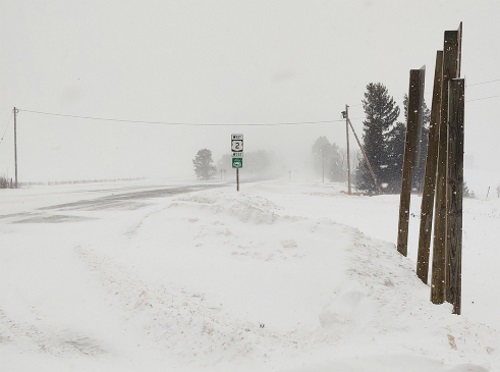A new report recently released by the Traffic Operations and Safety or “TOPS” Lab at the University of Wisconsin-Madison and funded by the Wisconsin Department of Transportation found the use of liquid brine in winter highway maintenance cleared roadways faster and at a lower cost, while providing for better vehicle traction and reducing salt buildup in local waterways.
[Above photo via the Wisconsin DOT]
“Liquid brine” is a simple mixture of salt and water used to clear winter roads and, for this study, the lab’s researchers looked at data from 143 storms occurring in 10 counties across Wisconsin. It compared brine-cleared routes to those nearby cleared with a traditional granular rock-salt method.
The data showed that brine-treated roads were:
- Clear (bare/wet condition) more than two hours faster on average.
- More likely to show a higher roadway friction rating.
- More efficient with material – reducing salt use on average by 23 percent.
“The data tells a very positive story for winter highway safety in Wisconsin,” said Andrea Bill, associate director of the TOPS Lab, housed in the UW-Madison College of Engineering. “Liquid brine is an effective tool, and along with training, education and technology, our storm fighters are making effective reductions in the amount of chloride on our roads and improving the performance of winter roads.”
[The winter operations podcast put together by the American Association of State Highway and Transportation Officials Snow and Ice Pooled Fund Cooperative Program, known as “SICOP,” recently produced an episode on Wisconsin’s brine study. To listen to it, click here.]
“With salt cost continuing to rise, it is imperative we work together to optimize supplies and deliver the most safe and effective service possible for the taxpayer,” noted Wisconsin DOT Secretary Craig Thompson in a statement.
“Liquid brine is a great example of how we strive to implement sustainable and earth-friendly alternatives during winter highway maintenance,” he added. “We applaud county highway departments across the state for using liquid brine to maintain and clear Wisconsin roadways faster.”
[Editor’s note: The Pennsylvania Department of Transportation is currently seeking public feedback on ways to improve its winter operations via an online survey. “Winter operations are among our core services and our team takes pride in their mission,” explained said PennDOT Secretary Yassmin Gramian in a statement. “Through this survey, the public can help us measure expectations and identify education opportunities.”]
Wisconsin counties use liquid brine in a variety of ways to help “optimize” the use of salt in fighting winter storms:
- Wetting roads with liquid brine before storms help prevent the bond of snow and ice to a driving surface.
- Using brine to wet granular salt as it is distributed both helps the salt stick to a roadway and activates the chemical reaction that melts snow and ice.
- Direct Liquid Applications or DLAs spray a brine solution directly to the roadway during winter events to break the bond between snow and the pavement.
The report found that, by creating a treatment option using less salt, brine can help stretch budgets and – by reducing salt usage – prevent the “bounce off” effect that increase granular salt build up in in lakes and streams.

